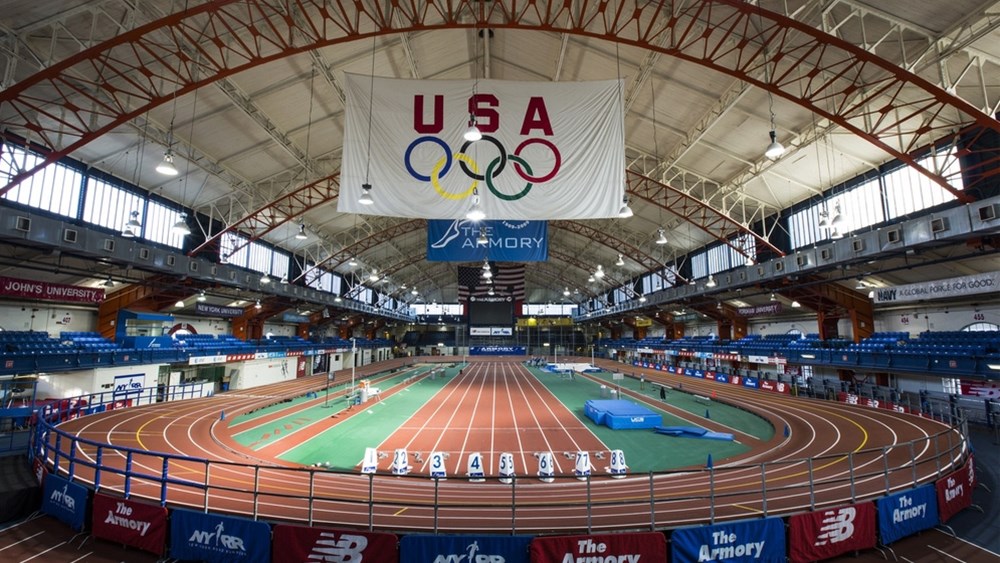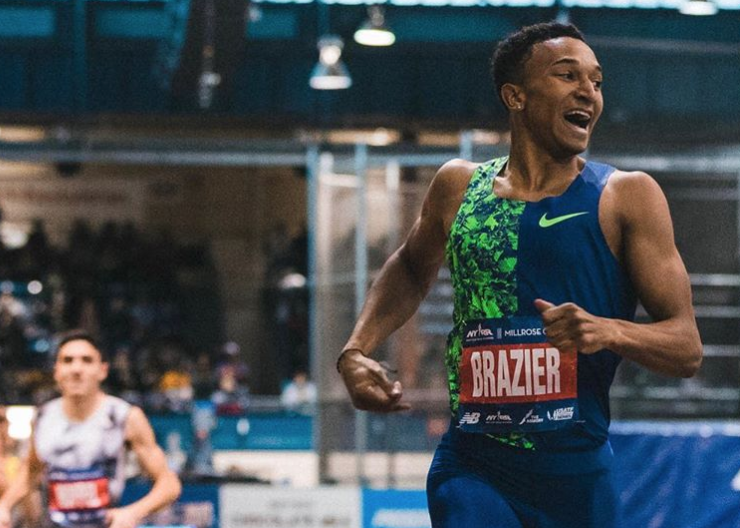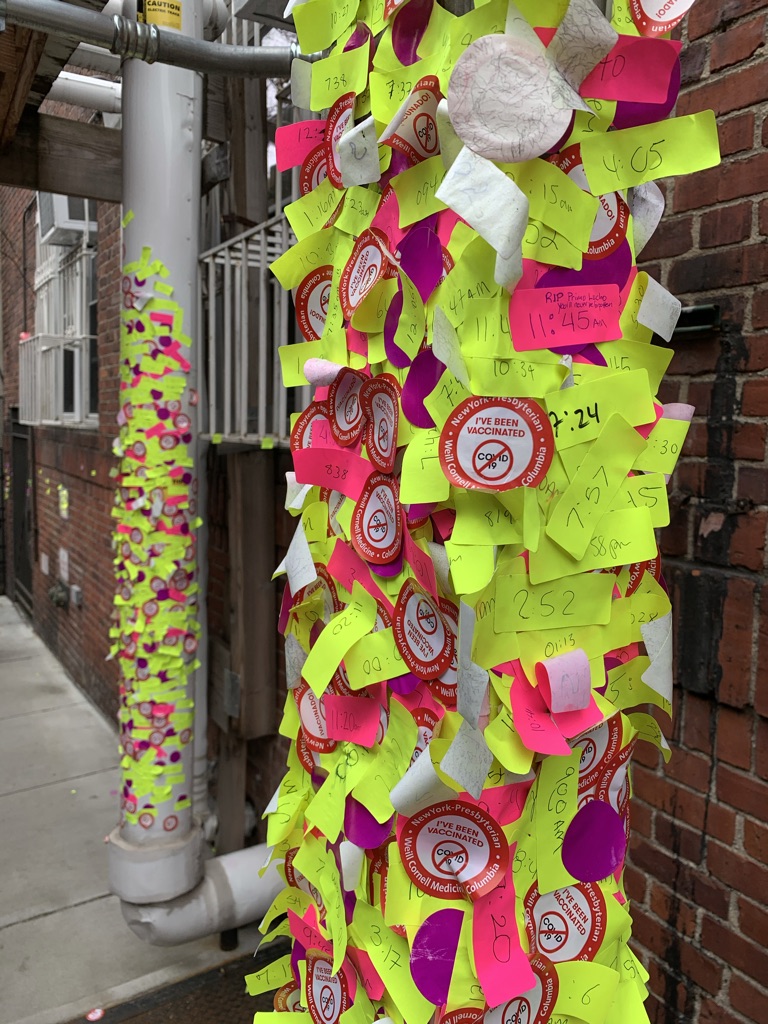It rained the day I received my first Covid19 vaccination. I was happy but not overjoyed. I respect the virus but I don’t fear it. So far, my adherence to the CDC guidelines to wear a mask, social distance and wash my hands have kept me free of the virus.
One person’s shot is anticlimactic anyway. We will not best the plague until millions of people are vaccinated. My inoculation would just be a shot in the ocean.
I was more excited that I would receive my inoculation at the 168th St Armory. You see, the Armory is home to one of the few world class indoor track facilities in the United States. My track and field community had stepped up and joined the fight against Covid19.
Sports venues around the country have been repurposed as Covid19 vaccine and test centers. In New York City, the Bronx has Yankee Stadium. Citi Field represents Queens. Washington Heights has the 168th St. Armory.
The Armory

It is fitting the Armory offered its space for a medical mission to serve its community. The man who restored the Armory from the decline much of NYC experienced in the 1970’s and 1980’s was the late Doctor Norbert Sander. He was an internist on City Island. Dr. Sander took pride in the American Records set at the meets hosted at the Armory. He also supported the City Track program the Armory sponsored to promote fitness and healthy living for the neighborhood Washington Heights kids.
Pennants almost two stories high jet out from the Armory’s facade. They tell part of the story behind the three story red brick building which spans nearly an entire city block.

A blue banner with the Armory’s winged foot logo adorns the building. The logos of their sponsors New Balance and the New York Road Runner, host of the NYC Marathon hang beside it. These pennants identify the building for visitors and the teams that arrive to compete. They might as well be hieroglyphics to the thousands of people who daily pass by.
I felt at home as I approached the 169th Street service entrance to the Armory. I had entered the building through this entrance countless times to see the world class meets annually held in the building. On this day, I came to protect my health and the health of others.
No Queue
A friendly woman greeted me to confirm my appointment. She placed a purple dot sticker on my black rain jacket to indicate I was there for my first shot. Next, I was sent down the track to a check-in table at the top of the first turn.
My walk along the homestretch of the track reminded me of the races I had seen at the Armory. Most recently, Donavan Brazier, Ajee Wilson and Elinor Purrier set American Records along this very spot in the previous year’s Millrose Games. I could feel their power.

Taking Care of Business
Workers buzzed around the infield of the track as they took care of their business. They seemed oblivious to the surroundings. As I chatted with my check-in worker I stated, “You know this building is like Madison Square Garden for Track and Field? Do you know how many Olympians and great athletes have competed on this track?” She blankly looked at me and replied, “I don’t know how anyone can run?” She handed me my appointment and vaccination cards. Then she waved me to the infield where I would receive my priceless vaccination.
I wanted to shake some sense into the woman and give her a tour of her workplace. Literally, thirty feet away from us was the USA Track and Field Museum. The red spikes Jim Hines wore in the 1968 Olympics to win the 100M and set the World Record were around the corner. She had no clue. Maybe Dorthy’s ruby red shoes at the Smithsonian would have been of more interest.
Every four years track and field captivates the world at the Olympics. In between the Games, the sport goes on but few take note.
Dr. Norb Sander
Dr. Saunder resurrected the Armory for the athletes. He raced at the Armory as a student at Fordham Prep. He continued to compete there when he attended Fordham University. This was in the late 50s and early 60s. At this time, lines on a wooden floor demarcated the track. A victory wasn’t a right of passage. Survival from a fall was.
In one legendary battle, Sander fell into the furniture and the spectators in an attempt to hold off a couple strong runners on the very first turn of a race. He proudly recounted,

kids from City Track
“Besides the splinters, I had floor burns. I was as red as a beet. My skin looked like it had gone through a meat grinder.”
Floor burns aside, Sander wanted as many kids as possible to experience the joy and fulfillment he derived from his running days. The Armory was his shrine, his holy place. A revitalized Armory would be his proxy.
All hands are on deck to fight Covid19. The Armory Vaccination site embodies this characterization.
A track person would compare the precision of the experience to the operation of the Penn Relays. Almost immediately, a nurse waved me to his station to receive my shot.
Which Arm?

The nurse warned of side effects, asked about health concerns and gave me my shot. My second inoculation would be in three weeks. The appointment was scheduled on a computer. It was also marked on my vaccination card which I put in my wallet.
I had to wait fifteen minutes before I could leave in order to make sure I didn’t suffer any side effects.
A yellow sticker with my departure time of 12:08 was placed on my jacket along with a two inch wide red and white circular sticker. It read, I”VE BEEN VACCINATED. Also printed on the sticker was a red circle with a slash. Inside the symbol was COVID19.
Hard Times
As I sat on the infield, I reminisced about the history of the Armory. In 1982, a homeless shelter was stationed in the expansive building. As the homelessness crisis overwhelmed the city, cots popped up in the Armory like mushrooms.
People now feared for their safety when they entered the building. Dr. Sander noted, “Every window was broken. All the plumbing was broken. Hermits were found living in the corners.”
Bishop Loughlin High School held a meet in the Armory for thirty-one years. It was the largest high school track meet in the country. It drew 4000 competitors from 300 schools in a ten state region. The 1984 edition was the last because of the deterioration of the Armory.
The pandemic has cast a similar blight on our country. Ironically, the vaccination center at the Armory is light at the end of the tunnel.
I Can See the Tape

12:08 arrived before I knew it. I left the building and headed east on 168th Street towards Broadway to take the 1 train home. A few steps up the street I noticed hundreds of people placed their yellow, purple, and fuchsia stickers on the pipes in front of a building.
A mosaic of hope formed on the pipes. The site reminded me of a driving force for all serious runners: Excellence does not happen immediately. One step at a time. Consistent hard work will prevail.
Every day the sticker tree grows like bamboo. Anyone who wants a vaccination can get it. The ocean will fill. Dr. Sander and the Armory played their part in the mission.

